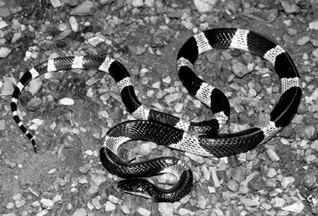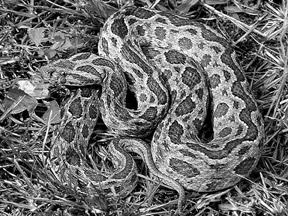Keep the killer trio at bay
by Amal HEWAVISSENTI
 |
|
Krait |
The mere sight of a venomous or even non-venomous snake slithering
towards you would make you instantly freeze in your tracks. Your initial
response would be to attack it or scream and run for safety. In short,
most of us have the tendency to kill any creature that has a long and
limbless body and threatens our survival instinct.
A few snakes are really life-threatening. However, most are harmless
snakes. Some like the hump-nosed viper or green viper have a bite which
if not treated well can be potentially fatal to the victim.
Conservationists claim that snakes support ecological balance and is a
reliable destroyer of mice, insects and other creatures that are harmful
to cultivations. Yet, most people kill them and justify what they have
done by simply claiming that they have destroyed death lurking in grass,
fissures, under pillows or any other place where snakes ensconce
themselves. This is true unfortunately, even non-venomous snakes are
killed in vain because of their resemblance to their dangerous cousins
and due to ignorance.
For example, the hump-nosed viper is often identified as a dangerous
viper and killed. Mapillas who live around houses are mistaken for
deadly kraits(karavala) and are beaten to death. This is a matter of
concern for conservationists because this process threatens the
eco-balance, of which snakes are an integral part.
 |
|
Russelís Viper |
Of the 96 species of snakes in Sri Lanka, only three types, the
cobra, krait (karavala) and viper (polanga) have virulent poison and
account for a large number of deaths annually in Sri Lanka. These are
the most dangerous snakes. However, it is important to note that these
snakes, venomous enough to kill a man with a single bite, do not, in
anyway, attack deliberately. They will ignore humans unless they are
attacked, provoked, hurt or pressed in any way.
Cobra - the king of poison
The cobra, which grows to about 1.5 metres in length, is easily
identifiable by his dangerously beautiful hood and body with undefined
white rings. If provoked, the cobra can make a lethal bite on a person
who if untreated, would die within four hours. It often attacks when it
is trampled, provoked or disturbed by man.
Many people are reluctant to kill the cobra as it is considered as a
sanctified symbol due to popular Buddhist legends. Superstitions claim
that the cobra, once attacked, becomes revengeful of the attacker. There
is another popular belief that the frequent presence of a cobra around a
house means the reincarnation of a member of that house who had died
with great attachment for the household members.
A cobra usually moves around in garbage dumps, marshes, fissures on
the ground or in any other place they can snuggle in. Anthills and
cavities in unplastered walls are ideal hiding places. Very often, the
cobra is found snuggling in corners and covered box-like objects in
houses. This is common because a cobra is attracted to houses by the
smell of frogs and mice which frequent many houses particularly at
night. A high level of danger is posed to the householders because a
cobra after mice, may be lurking somewhere in the house and may be
trampled by somebody walking heedlessly.
Krait - cause of unexplained death
The krait (karavala) is another highly venomous snake commonly seen
around houses, gardens, in small spaces between the walls of two
buildings, coconut trees and sometimes even under pillows. It is
unarguably the second most poisonous snake in Sri Lanka and may
sometimes account for unexplained deaths in a household. A marked trait
of the krait bite is that it is hardly felt by the victim. A fully grown
krait is around 700mm in length. They are of two types; Sri Lankan Krait
(Mudu Karavala) and Indian Krait (Thel Karavala). The Mudu Karavala is
usually black in colour with white rings while the Thel Karavala has an
extremely glossy brown skin. Kraits usually come after smaller snakes
and hide in cavities in the house. They tend to snuggle under
mattresses, pillows, in cupboards and narrow corners; they dwell on
coconut trees and in all kinds of cavities outside houses.
 |
|
Russelís Viper |
The krait is responsible for the majority of deaths caused by snake
bites in areas of habitation as it mostly dwells in and around houses
seeking smaller snakes and other creatures for prey. Most deaths
occurring at night are ascribed to krait bites as they remain ensconced
under pillows, bedsheets, or mattresses. It becomes active at night and
when a sleeping person unknowingly presses hard on the snake, it bites
the sleeper, injecting death into him/her.
A man who climbs a coconut tree is exposed to the danger of being
bitten by a krait because the top part of a coconut tree is a favourite
hideout for this snake. The peril lies in that the person is unaware of
being bitten.
Viper - aggressive attacker
The viper is a poisonous snake with large front fangs and a patterned
body. The most marked characteristic of the viper is that it prefers to
dwell in overgrown gardens, tall grass, and jungles rather than in human
habitations. This is a highly aggressive snake which has the capacity to
spring up several feet and attack the enemy or prey with pinpoint
accuracy. It springs up several times with fangs ready to inject venom
without giving any room for the enemy to block or avoid it.
Its venom is fatally virulent. Sometimes it loops its body around a
person's legs and attacks several spots as the victim struggles to jerk
it off the feet. A person walking on tall grass is most vulnerable to
viper attacks because the movement of feet and the rustling of grass are
wrongly identified by the snake to be a moving frog or mouse. That is
why vipers launch unexpected attacks on people. So be careful when
walking among tall grass, particularly at dusk when the snakes begin to
be active.
First aid
A victim of a snake bite is frozen scared when he see the snake after
the attack. Therefore ,first aid to calm the mind is the most important
thing because the agitated mind may accelerate the movement of poison
throughout the body. Console the victim and assure him/her that the
particular snake is not that poisonous and that he/she is being admitted
to hospital for further treatment. Wash the area of the bite with clean
water and cover it with a clean piece of cloth. Remove any rings or
bracelets worn by the victim. Take care not to move or shake the bitten
hand or leg. It is better to carry the patient to the nearest hospital
as soon as possible. If the patient happens to be under heavy pain give
him/her paracetamol to suppress the pain. (However, never give
paracetamol in the event of a krait bite).
The don'ts
* Don't strain the patient in anyway. Bandage the wound somewhat
loosely.
* Don't cut off slices of skin from the place of bite. People are
under the delusion that all the poison can be easily removed by cutting
a slice off the wound area.
* Don't burn the skin around the wound. It is a myth that the poison
can be neutralised by burning the would.
* Never give any type of alcoholic drink or aspirin.
* Don't let the patient move about.
* Never do experiments with the patient or try out local medicines
made from herbs.
Avoid snake bites
 A snake does not mean harm to people, but it is compelled to attack
them for self-defence. Conservationists vehemently protest the killing
of snakes because they claim that it leads to environmental hazards.
Snakes effectively destroy the insects and mice that infest
cultivations, thereby serving the agriculture industry. Moreover,
venomous snakes provide the much-needed venom for medical scientists to
produce antivenom for snake bites. A snake does not mean harm to people, but it is compelled to attack
them for self-defence. Conservationists vehemently protest the killing
of snakes because they claim that it leads to environmental hazards.
Snakes effectively destroy the insects and mice that infest
cultivations, thereby serving the agriculture industry. Moreover,
venomous snakes provide the much-needed venom for medical scientists to
produce antivenom for snake bites.
1. When you go out at night, take a torch or a source of light with
you.
2. Be cautious, wear knee-length boots specially when you are walking
along a path with weed growth or through a jungle.
3. Avoid walking outdoors when it is dark.
4. Keep your eyes on the path. Most snake bites (70 percent) are
inflicted on the feet.
5. Be mindful when arranging piles of wood or similar things. Snakes
prefer such places.
|

